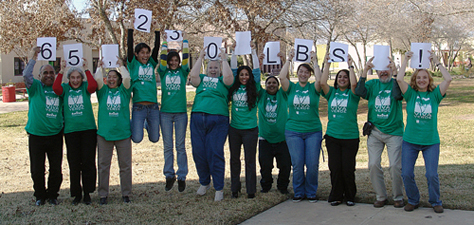The Pulse Archives
Another green year at Palo Alto
By Robert Michael Herrera | Pulse Staff Reporter
 Palo Alto College is talking trash about its recycling program, one of the college district’s greatest green success stories.
Palo Alto College is talking trash about its recycling program, one of the college district’s greatest green success stories.
The campus recycling rate increased by 16 percent from the previous year as students, faculty and staff celebrated their rescuing of 65,230 pounds of paper, plastic, cardboard, metal and glass in 2011, exceeding 2010’s total by 10,437 pounds.
Dr. Denise Barkis Richter, professor of Communication and chair of the Go Green ¡Viva Verde! Committee, keeps everyone aware of the importance of recycling.
“Not only is she green, but she sends us emails all the time! I can’t help but open at least one email and read what is so important,” said Rena Bofferding, an undecided freshman.
More than 42 volunteers, six student government senators and work-study Norberto Flores collect recyclables throughout the campus on a weekly basis. This volunteer-run program is the largest in the college district. Volunteers have contributed to keep the program going for over three years.
Recycling at Palo Alto couldn’t be any easier. After a lunch break or quick snack, students run into a real decision when discarding their trash. The decision to recycle or not remains within the individual: put his or her empty bottle of Coke into the trash or be green and recycle.
The recycling program provides the cafeteria, classrooms and many other areas on campus with green bins to make recycling easy and routine. Notes and posters are placed nearby to inform those who walk by what can and cannot be recycled.
The only rules one must keep in mind are to put trash in the trash cans and to make sure plastic, metal and glass containers are empty before placing them in the green bins.
“It’s too easy not to recycle,” said Frank Martinez, a sophomore Criminal Justice major. “When I throw away my lunch every day, I can’t help but read the signs and see the green recycling bins right in front of me. So it’s simple. I put my plastic bottle, sometimes two, and maybe a can in the green bin and then I just walk off straight to class.”
Not everyone has a great opinion of recycling. Some ignore the school’s efforts and discard their potential recyclable items into the trash.
“Why should I waste my time for something I bought with my own money and just give it back to save a few flowers?” asked Tim Ortega, a freshman Math major. “It’s just like voting. How can my one bottle or can make a difference?”
Recycling one ton of paper, approximately 2,000 pounds, saves 17 trees from being cut down. Recycling two aluminum cans saves the equivalent energy needed to power a computer for one workday. Recycling fourteen 20-ounce plastic bottles yields enough fiber to make an extra-large T-shirt.
Palo Alto is contributing to a world recycling effort to decrease its impact on the globe. Students, faculty and staff are working together to preserve the planet from depletion and exhaustion.
John Hernandez, a sophomore Kinesiology major, said, “It’s important that the recycling program continues for many years to come as long as the determination and goals are clear to the campus. Recycling can save the world and each other, but only if we want it to. We all have a decision to make. Whether or not we do it will unveil our fate.”
March 2012
- Father, mother, sister, brother attend Palo Alto
- Palo Alto recognizes teaching excellence
- Construction projects receive mixed feedback
- SOPA and PIPA remain mysteries for most
- Student veterans organization provides support
- Bikeshare program cruises into Palo Alto
- Another green year at Palo Alto
- To e-book or not to e-book?
- Palo Alto, the college for you
- Ten tips for successful learning
- Healthy steps for a balanced life
- How to write a resume the right way
- Why graduate and not just transfer?
- Sweet Anticipation: Spring Break 2012